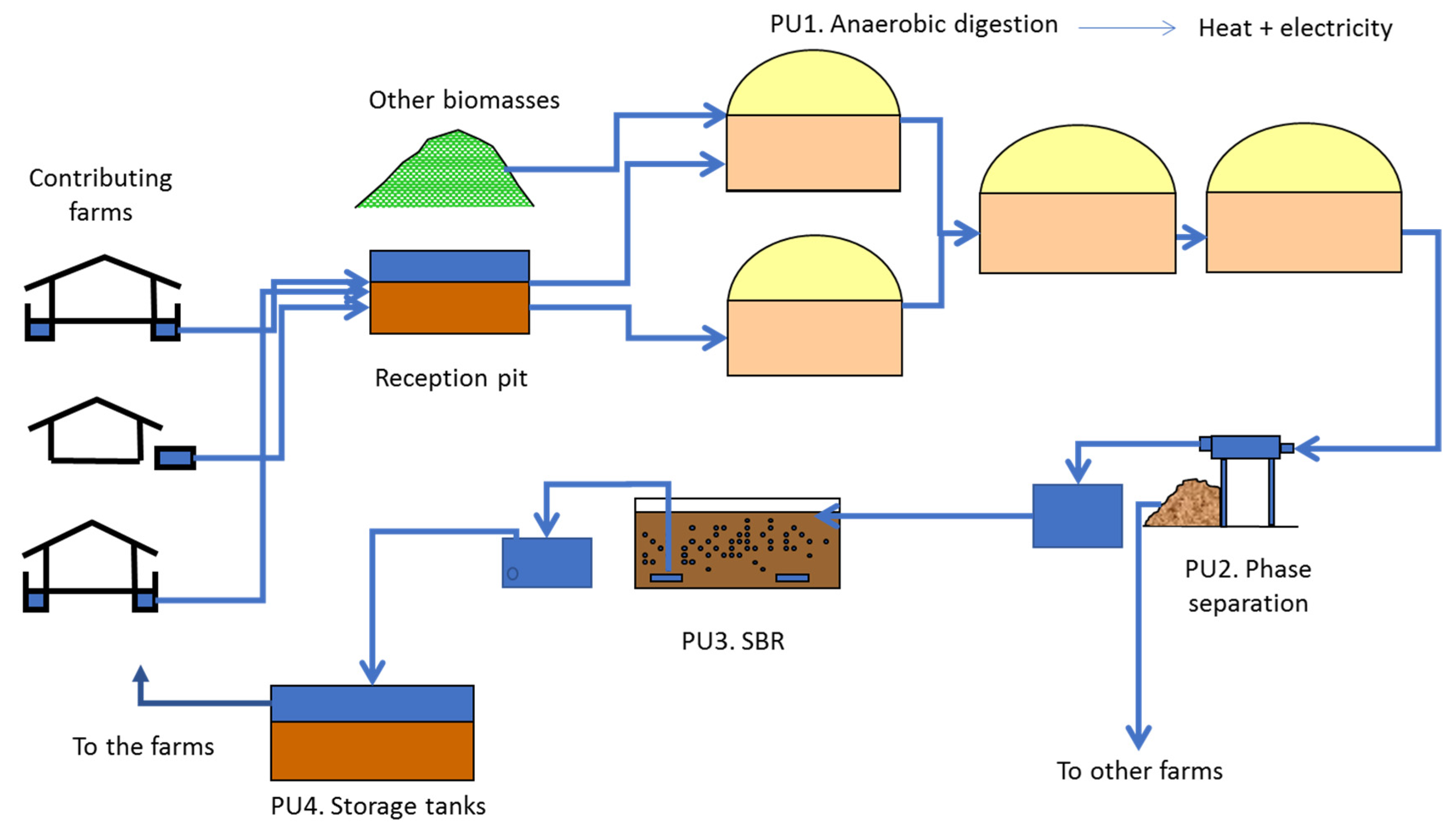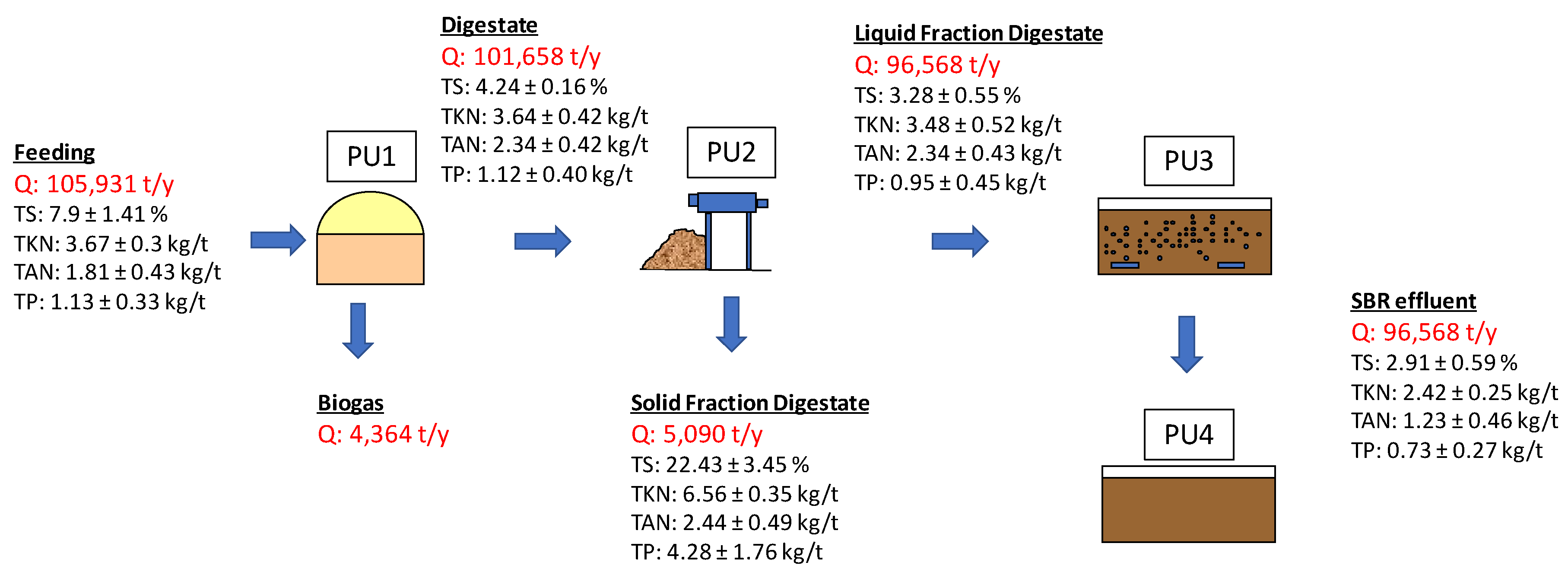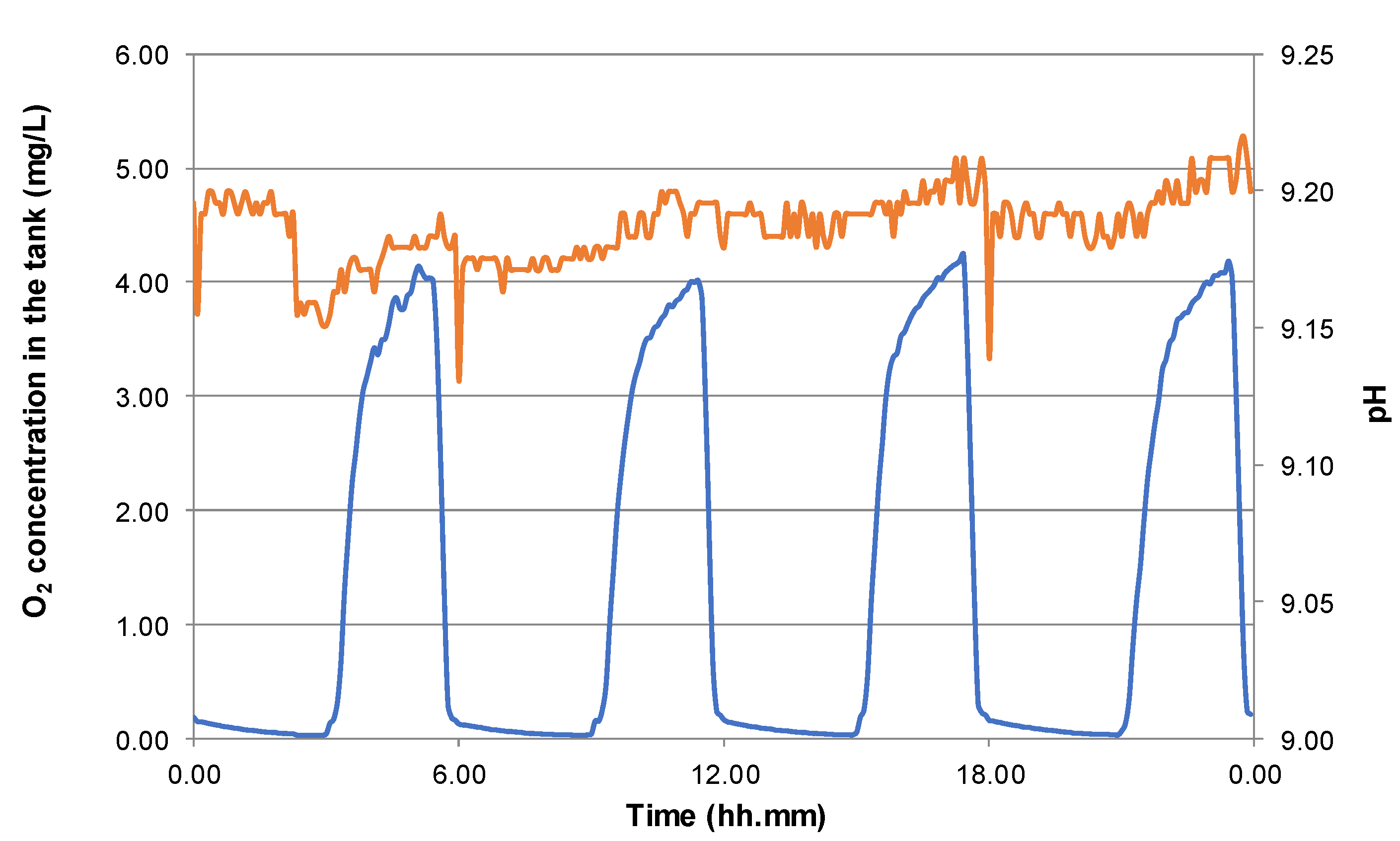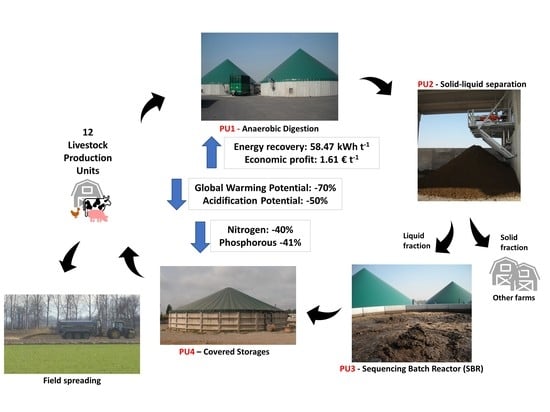Technical, Economic, and Environmental Assessment of a Collective Integrated Treatment System for Energy Recovery and Nutrient Removal from Livestock Manure
Abstract
1. Introduction
2. Materials and Methods
2.1. Description of the Management System
2.2. Scheme of the System and Treatment Units
2.3. Monitoring and Data Collection
2.4. Mass Balance and Nutrient Balance
2.5. Methodology to Assess the Manure Management System
2.5.1. Environmental Balance
2.5.2. Agronomic Balance
2.5.3. Economic Balance
2.5.4. Energy Balance
2.5.5. Social Impact and Biosecurity
3. Results and Discussion
3.1. Mass Balance and Nutrient Balance
3.1.1. Anaerobic Digestion (PU1)
3.1.2. Solid–Liquid Separation (PU2)
3.1.3. SBR Treatment Plant (PU3) and Final Storage (PU4)
3.1.4. Comparison with Other Case Studies
3.2. Assessment of the Manure Management System
3.2.1. Environmental Balance
3.2.2. Agronomic Balance
3.2.3. Economic Balance
3.2.4. Energy Balance
3.2.5. Social Impact and Biosecurity
4. Conclusions
Author Contributions
Funding
Acknowledgments
Conflicts of Interest
References
- Hou, Y.; Velthof, G.; Lesschen, J.P.; Staritsky, I.G.; Oenema, O. Nutrient Recovery and Emissions of Ammonia, Nitrous Oxide, and Methane from Animal Manure in Europe: Effects of Manure Treatment Technologies. Environ. Sci. Technol. 2016, 51, 375–383. [Google Scholar] [CrossRef] [PubMed]
- Erisman, J.W.; Bleeker, A.; Hensen, A.; Vermeulen, A. Agricultural air quality in Europe and the future perspectives. Atmospheric Environ. 2008, 42, 3209–3217. [Google Scholar] [CrossRef]
- Bouraoui, F.; Grizzetti, B. Long term change of nutrient concentrations of rivers discharging in European seas. Sci. Total. Environ. 2011, 409, 4899–4916. [Google Scholar] [CrossRef] [PubMed]
- Burton, C.H.; Turner, C. Manure Management: Treatment Strategies for Sustainable Agriculture, 2nd ed.; Silsoe Research Institute: Bedford, UK, 2003; pp. 57–108. [Google Scholar]
- Loyon, L. Overview of manure treatment in France. Waste Manag. 2017, 61, 516–520. [Google Scholar] [CrossRef]
- Petersen, S.O.; Sommer, S.G.; Béline, F.; Burton, C.; Dach, J.; Dourmad, J.; Leip, A.; Misselbrook, T.; Nicholson, F.; Poulsen, H.; et al. Recycling of livestock manure in a whole-farm perspective. Livest. Sci. 2007, 112, 180–191. [Google Scholar] [CrossRef]
- Oenema, O.; Oudendag, D.; Velthof, G. Nutrient losses from manure management in the European Union. Livest. Sci. 2007, 112, 261–272. [Google Scholar] [CrossRef]
- González, M.C.G.; Riaño, B.; Teresa, M.; Herrero, E.; Ward, A.J.; Provolo, G.; Moscatelli, G.; Piccinini, S.; Bonmati, A.; Bernal, M.P.; et al. Treatment of swine manure: Case studies in European’s N-surplus areas. Sci. Agricola 2016, 73, 444–454. [Google Scholar] [CrossRef]
- Flotats, X.; Foged, H.L.; Bonmati, A.; Palatsi, J.; Magri, A.; Schelde, K.M. Manure Processing Technologies; Technical Report No. II Concerning “Manure Processing Activities in Europe” to the European Commission, Directorate-General Environment; Agro Business Park: Tjele, Denmark, 28 October 2011. [Google Scholar]
- Flotats, X.; Bonmati, A.; Fernández, B.; Magrí, A. Manure treatment technologies: On-farm versus centralized strategies. NE Spain as case study. Bioresour. Technol. 2009, 100, 5519–5526. [Google Scholar] [CrossRef]
- Bonmati, A.; Flotats, X. Air stripping of ammonia from pig slurry: Characterisation and feasibility as a pre- or post-treatment to mesophilic anaerobic digestion. Waste Manag. 2003, 23, 261–272. [Google Scholar] [CrossRef]
- Guštin, S.; Marinšek-Logar, R. Effect of pH, temperature and air flow rate on the continuous ammonia stripping of the anaerobic digestion effluent. Process. Saf. Environ. Prot. 2011, 89, 61–66. [Google Scholar] [CrossRef]
- Jiang, A.; Zhang, T.; Zhao, Q.-B.; Li, X.; Chen, S.; Frear, C.S. Evaluation of an integrated ammonia stripping, recovery, and biogas scrubbing system for use with anaerobically digested dairy manure. Biosyst. Eng. 2014, 119, 117–126. [Google Scholar] [CrossRef]
- Provolo, G.; Perazzolo, F.; Mattachini, G.; Finzi, A.; Naldi, E.; Riva, E. Nitrogen removal from digested slurries using a simplified ammonia stripping technique. Waste Manag. 2017, 69, 154–161. [Google Scholar] [CrossRef] [PubMed]
- Bernet, N. Combined anaerobic–aerobic SBR for the treatment of piggery wastewater. Water Res. 2000, 34, 611–619. [Google Scholar] [CrossRef]
- Finzi, A.; Riva, E.; Bicoku, A.; Guido, V.; Shallari, S.; Provolo, G. Comparison of techniques for ammonia emission mitigation during storage of livestock manure and assessment of their effect in the management chain. J. Agric. Eng. 2019, 50, 12–19. [Google Scholar] [CrossRef]
- Hjorth, M.; Christensen, K.; Christensen, M.L.; Sommer, S.G. Solid—liquid separation of animal slurry in theory and practice. A review. Agron. Sustain. Dev. 2010, 30, 153–180. [Google Scholar] [CrossRef]
- Choi, E.; Kim, D.; Eum, Y.; Yun, Z.; Min, K.-S. Full-Scale Experience for Nitrogen Removal from Piggery Waste. Water Environ. Res. 2005, 77, 381–389. [Google Scholar] [CrossRef] [PubMed]
- Deng, L.; Cai, C.; Chen, Z. The treatment of pig slurry by a full-scale Anaerobic-Adding Raw Wastewater-Intermittent Aeration Process. Biosyst. Eng. 2007, 98, 327–334. [Google Scholar] [CrossRef]
- Lopéz-Ridaura, S.; Van Der Werf, H.M.G.; Paillat, J.M.; Le Bris, B. Environmental evaluation of transfer and treatment of excess pig slurry by life cycle assessment. J. Environ. Manag. 2009, 90, 1296–1304. [Google Scholar] [CrossRef]
- Magrí, A.; Flotats, X. Modelling of biological nitrogen removal from the liquid fraction of pig slurry in a sequencing batch reactor. Biosyst. Eng. 2008, 101, 239–259. [Google Scholar] [CrossRef]
- Ledda, C.; Schievano, A.; Salati, S.; Adani, F. Nitrogen and water recovery from animal slurries by a new integrated ultrafiltration, reverse osmosis and cold stripping process: A case study. Water Res. 2013, 47, 6157–6166. [Google Scholar] [CrossRef]
- Perera, P.A.; Wu, W.-X.; Chen, Y.-X.; Han, Z.-Y. Struvite Recovery from Swine Waste Biogas Digester Effluent through a Stainless Steel Device under Constant pH Conditions. Biomed. Environ. Sci. 2009, 22, 201–209. [Google Scholar] [CrossRef]
- Vaneeckhaute, C.; Lebuf, V.; Michels, E.; Belia, E.; Vanrolleghem, P.; Tack, F.M.G.; Meers, E. Nutrient Recovery from Digestate: Systematic Technology Review and Product Classification. Waste Biomass- Valorization 2016, 8, 21–40. [Google Scholar] [CrossRef]
- Asai, M.; Langer, V.; Frederiksen, P.; Jacobsen, B. Livestock farmer perceptions of successful collaborative arrangements for manure exchange: A study in Denmark. Agric. Syst. 2014, 128, 55–65. [Google Scholar] [CrossRef]
- Zemo, K.H.; Termansen, M. Farmers’ willingness to participate in collective biogas investment: A discrete choice experiment study. Resour. Energy Econ. 2018, 52, 87–101. [Google Scholar] [CrossRef]
- Provolo, G.; Mattachini, G.; Finzi, A.; Cattaneo, M.; Guido, V.; Riva, E. Global Warming and Acidification Potential Assessment of a Collective Manure Management System for Bioenergy Production and Nitrogen Removal in Northern Italy. Sustainability 2018, 10, 3653. [Google Scholar] [CrossRef]
- Massé, D.I.; Talbot, G.; Gilbert, Y. On farm biogas production: A method to reduce GHG emissions and develop more sustainable livestock operations. Anim. Feed. Sci. Technol. 2011, 436–445. [Google Scholar] [CrossRef]
- Yiridoe, E.; Gordon, R.; Brown, B.B. Nonmarket cobenefits and economic feasibility of on-farm biogas energy production. Energy Policy 2009, 37, 1170–1179. [Google Scholar] [CrossRef]
- De Vries, J.; Groenestein, C.; Schröder, J.; Hoogmoed, W.; Sukkel, W.; Koerkamp, P.G.; De Boer, I.J.M. Integrated manure management to reduce environmental impact: II. Environmental impact assessment of strategies. Agric. Syst. 2015, 138, 88–99. [Google Scholar] [CrossRef]
- Standard methods for the examination of water and wastewater. Choice Rev. Online 2012, 49, 49.
- Dinuccio, E.; Berg, W.; Balsari, P. Gaseous emissions from the storage of untreated slurries and the fractions obtained after mechanical separation. Atmospheric Environ. 2008, 42, 2448–2459. [Google Scholar] [CrossRef]
- Petersen, S.O.; Andersen, A.J.; Eriksen, J. Effects of Cattle Slurry Acidification on Ammonia and Methane Evolution during Storage. J. Environ. Qual. 2012, 41, 88–94. [Google Scholar] [CrossRef] [PubMed]
- Balsari, P.; Airoldi, G.; Dinuccio, E.; Gioelli, F. Ammonia emissions from farmyard manure heaps and slurry stores—Effect of environmental conditions and measuring methods. Biosyst. Eng. 2007, 97, 456–463. [Google Scholar] [CrossRef]
- Chowdhury, A.; De Neergaard, A.; Jensen, L.S. Composting of solids separated from anaerobically digested animal manure: Effect of different bulking agents and mixing ratios on emissions of greenhouse gases and ammonia. Biosyst. Eng. 2014, 124, 63–77. [Google Scholar] [CrossRef]
- Yamulki, S.; Jarvis, S.C. Automated chamber technique for gaseous flux measurements: Evaluation of a photoacoustic infrared spectrometer-trace gas analyzer. J. Geophys. Res. Space Phys. 1999, 104, 5463–5469. [Google Scholar] [CrossRef]
- Ministerial Decree n.5046/2016. On “General Technical Criteria and Standards for the Regional Regulations of the Agronomic Use of Farm Effluents and Wastewater and for the Production and Agronomic Use of Digestate”. Available online: https://www.gazzettaufficiale.it/eli/id/2016/04/18/16A02762/sg. (accessed on 18 January 2020).
- Provolo, G.; Manuli, G.; Finzi, A.; Lucchini, G.; Riva, E.; Sacchi, G.A. Effect of Pig and Cattle Slurry Application on Heavy Metal Composition of Maize Grown on Different Soils. Sustainability 2018, 10, 2684. [Google Scholar] [CrossRef]
- European Environment Agency. EMEP/EEA Air Pollution Emission Inventory Guidebook 2016; Publications Office of the European Union: Brussels, Belgium, 2016; pp. 1–28. [Google Scholar]
- Eggleston, H.S.; Buendia, L.; Miwa, K.; Ngara, T.; Tanabe, K. IPCC Guidelines for National Greenhouse Gas Inventories; Intergovernmental Panel on Climate Change, Ed.; IGES: Hayama, Japan, 2006; Volumes 2–4, Chapter 3; pp. 10–11. [Google Scholar]
- National Guidelines for Integrated Production, Act n.4/2011. Available online: https://www.reterurale.it/flex/cm/pages/ServeBLOB.php/L/IT/IDPagina/3928 (accessed on 18 January 2020).
- European Committee for Standardization (CEN). Air quality—Determination of Odour Concentration by Dynamic Olfactometry. BS EN 2003, 13725, 2003. [Google Scholar]
- AOAC. Official Methods of Analysis of the Association of Official Analytical Chemists 17th ed. Current through Revision Arlington, USA: Method Nr. 991;14. Available online: http://eoma.aoac.org/methods/info.asp?ID=46949 (accessed on 18 January 2020).
- International Standard Organization. Microbiology of Food and Animal Feeding Stuffs—Horizontal Method for the Detection of Salmonella spp.; ISO: Geneva, Switzerland, 2008; pp. 1–27. [Google Scholar]
- Schievano, A.; D’Imporzano, G.; Salati, S.; Adani, F. On-field study of anaerobic digestion full-scale plants (Part I): An on-field methodology to determine mass, carbon and nutrients balance. Bioresour. Technol. 2011, 102, 7737–7744. [Google Scholar] [CrossRef]
- Schievano, A.; D’Imporzano, G.; Orzi, V.; Adani, F. On-field study of anaerobic digestion full-scale plants (Part II): New approaches in monitoring and evaluating process efficiency. Bioresour. Technol. 2011, 102, 8814–8819. [Google Scholar] [CrossRef]
- Möller, K.; Müller, T. Effects of anaerobic digestion on digestate nutrient availability and crop growth: A review. Eng. Life Sci. 2012, 12, 242–257. [Google Scholar] [CrossRef]
- Deng, L.; Zheng, P.; Chen, Z.; Mahmood, Q. Improvement in post-treatment of digested swine wastewater. Bioresour. Technol. 2008, 99, 3136–3145. [Google Scholar] [CrossRef]
- Han, Z.; Wu, W.; Chen, Y.; Zhu, J. Characteristics of a twice-fed sequencing batch reactor treating swine wastewater under control of aeration intensity. J. Environ. Sci. Heal. Part A 2007, 42, 361–370. [Google Scholar] [CrossRef] [PubMed]
- Obaja, D. Biological nutrient removal by a sequencing batch reactor (SBR) using an internal organic carbon source in digested piggery wastewater. Bioresour. Technol. 2005, 96, 7–14. [Google Scholar] [CrossRef]
- Zhu, J.; Zhang, Z.; Miller, C. A Laboratory Scale Sequencing Batch Reactor with the Addition of Acetate to remove Nutrient and Organic Matter in Pig Slurry. Biosyst. Eng. 2006, 93, 437–446. [Google Scholar] [CrossRef]
- Lo, K.V.; Liao, P.H. A full-scale sequencing batch reactor system for swine wastewater treatment. J. Environ. Sci. Heal. Part B 2007, 42, 237–240. [Google Scholar]
- Bortone, G. Integrated anaerobic/aerobic biological treatment for intensive swine production. Bioresour. Technol. 2009, 100, 5424–5430. [Google Scholar] [CrossRef] [PubMed]
- Dube, P.; Vanotti, M.; Szogi, A.; González, M.C.G. Enhancing recovery of ammonia from swine manure anaerobic digester effluent using gas-permeable membrane technology. Waste Manag. 2016, 49, 372–377. [Google Scholar] [CrossRef]
- Loyon, L.; Guiziou, F.; Béline, F.; Peu, P. Gaseous Emissions (NH3, N2O, CH4 and CO2) from the aerobic treatment of piggery slurry—Comparison with a conventional storage system. Biosyst. Eng. 2007, 97, 472–480. [Google Scholar] [CrossRef]
- Vanotti, M.; Szögi, A.A.; Millner, P.D.; Loughrin, J. Development of a second-generation environmentally superior technology for treatment of swine manure in the USA. Bioresour. Technol. 2009, 100, 5406–5416. [Google Scholar] [CrossRef]
- Wang, L.; Addy, M.; Liu, J.; Nekich, C.; Zhang, R.; Peng, P.; Cheng, Y.; Cobb, K.; Liu, Y.; Wang, H.; et al. Integrated process for anaerobically digested swine manure treatment. Bioresour. Technol. 2019, 273, 506–514. [Google Scholar] [CrossRef]
- Bolzonella, D.; Fatone, F.; Gottardo, M.; Frison, N. Nutrients recovery from anaerobic digestate of agro-waste: Techno-economic assessment of full scale applications. J. Environ. Manag. 2018, 216, 111–119. [Google Scholar] [CrossRef]
- Cattaneo, M.; Finzi, A.; Guido, V.; Riva, E.; Provolo, G. Effect of ammonia stripping and use of additives on separation of solids, phosphorus, copper and zinc from liquid fractions of animal slurries. Sci. Total. Environ. 2019, 672, 30–39. [Google Scholar] [CrossRef] [PubMed]
- Nicholson, F.; Chambers, B.; Williams, J.; Unwin, R. Heavy metal contents of livestock feeds and animal manures in England and Wales. Bioresour. Technol. 1999, 70, 23–31. [Google Scholar] [CrossRef]
- Moral, R.; Murcia, M.D.P.; Espinosa, A.P.; Moreno-Caselles, J.; Paredes, C.; Rufete, B. Salinity, organic content, micronutrients and heavy metals in pig slurries from South-eastern Spain. Waste Manag. 2008, 28, 367–371. [Google Scholar] [CrossRef] [PubMed]
- Bacenetti, J.; Sala, C.; Fusi, A.; Fiala, M. Agricultural anaerobic digestion plants: What LCA studies pointed out and what can be done to make them more environmentally sustainable. Appl. Energy 2016, 179, 669–686. [Google Scholar] [CrossRef]
- De Vrieze, J.; Colica, G.; Pintucci, C.; Sarli, J.; Pedizzi, C.; Willeghems, G.; Bral, A.; Varga, S.; Prat, D.; Peng, L.; et al. Resource recovery from pig manure via an integrated approach: A technical and economic assessment for full-scale applications. Bioresour. Technol. 2019, 272, 582–593. [Google Scholar] [CrossRef] [PubMed]




| Criteria | Indicators | Parameter |
|---|---|---|
| Environment | WATER: Eutrophication | N balance, P balance |
| AIR: Acidification | NH3, SO2, NOx emissions | |
| AIR: Global Warming | CO2, CH4, N2O emissions | |
| Agronomy | Fertilizing units NP | NP Balance |
| Economy | Incomes | Energy production, end-products |
| Expenses | Depreciation, energy consumption, chemicals, maintenance, manpower | |
| Energy | Energy production | Electricity and heat |
| Energy consumption | Electricity, heat, and fuel | |
| Social impact | Odor | Reference values |
| Noise | Reference values | |
| Impact in local activity | Jobs created | |
| Biosecurity | E. coli | Reduction/No reduction |
| Salmonella | Reduction/No reduction |
| Phase | N-NH3 | N2O | CO2 | CH4 |
|---|---|---|---|---|
| 1. Filling/decanting (g/m3/cycle) | 0.014 (0.01) | 0.000 (0.00) | 0.088 (0.10) | 0.010 (0.01) |
| 2. Anoxic reaction/mixing (g/m3/cycle) | 0.076 (0.03) | 0.002 (0.00) | 0.437 (0.19) | 0.058 (0.02) |
| 3. Aerobic reaction (g/m3/cycle) | 0.163 (0.07) | 0.001 (0.00) | 5.221 (1.39) | 0.086 (0.04) |
| 4. Settling/sedimentation (g/m3/cycle) | 0.017 (0.00) | 0.000 (0.00) | 0.093 (0.03) | 0.005 (0.00) |
| Total cycle (g/m3/cycle) | 0.271 (0.10) | 0.003 (0.00) | 5.840 (1.61) | 0.157 (0.06) |
| Day (g/m3/d) | 1.08 (0.41) | 0.01 (0.02) | 23.36 (6.44) | 0.63 (0.25) |
| Criteria | Parameter | Units | With Treatment System | Without Treatment System |
|---|---|---|---|---|
| Environment (1) | Global Warming Potential | kg CO2 eq./t treated | 20.79 | 74.30 |
| Acidification potential | kg SO2 eq./t treated | 0.90 | 1.83 | |
| Land available (170 kgN/ha) | ha | 1112 | 1840 | |
| Agronomy (1) | Nitrogen Balance | kg N/ha | 250 | 361 |
| Phosphorus Balance | kg P/ha | 118 | 191 | |
| Economy (2) | Incomes | €/t | 18.43 | 0 |
| Expenses | €/t | 16.82 | 0 | |
| Energy (3) | Electrical Energy Balance | kWh/t | 58.47 | 0 |
| Thermal Energy Balance | kWh/t | - | 0 | |
| Fuel | kWh/t | 0.99 | 0 | |
| Social Impact (2) | Job demand—Operator | h/y | 6800 | 0 |
| Job demand—Technician | h/y | 425 | 0 | |
| Odor | 1(little)-4(much) | 1 | - | |
| Noise | YES/NO | NO | - | |
| Biosecuriy | Pathogens reduction | E. coli | 99.6% | 0% |
| Pathogens reduction | Salmonella | absent/present | present |
| Nutrient | Crop Requirements | Output without Treatment Plant | Surplus | Output with Treatment Plant | Surplus |
|---|---|---|---|---|---|
| kg/ha | |||||
| Nitrogen (*) | 352 | 361 | 9 | 250 | −102 |
| Phosphorus (**) | 113 | 191 | 78 | 118 | 5 |
© 2020 by the authors. Licensee MDPI, Basel, Switzerland. This article is an open access article distributed under the terms and conditions of the Creative Commons Attribution (CC BY) license (http://creativecommons.org/licenses/by/4.0/).
Share and Cite
Finzi, A.; Mattachini, G.; Lovarelli, D.; Riva, E.; Provolo, G. Technical, Economic, and Environmental Assessment of a Collective Integrated Treatment System for Energy Recovery and Nutrient Removal from Livestock Manure. Sustainability 2020, 12, 2756. https://doi.org/10.3390/su12072756
Finzi A, Mattachini G, Lovarelli D, Riva E, Provolo G. Technical, Economic, and Environmental Assessment of a Collective Integrated Treatment System for Energy Recovery and Nutrient Removal from Livestock Manure. Sustainability. 2020; 12(7):2756. https://doi.org/10.3390/su12072756
Chicago/Turabian StyleFinzi, Alberto, Gabriele Mattachini, Daniela Lovarelli, Elisabetta Riva, and Giorgio Provolo. 2020. "Technical, Economic, and Environmental Assessment of a Collective Integrated Treatment System for Energy Recovery and Nutrient Removal from Livestock Manure" Sustainability 12, no. 7: 2756. https://doi.org/10.3390/su12072756
APA StyleFinzi, A., Mattachini, G., Lovarelli, D., Riva, E., & Provolo, G. (2020). Technical, Economic, and Environmental Assessment of a Collective Integrated Treatment System for Energy Recovery and Nutrient Removal from Livestock Manure. Sustainability, 12(7), 2756. https://doi.org/10.3390/su12072756






